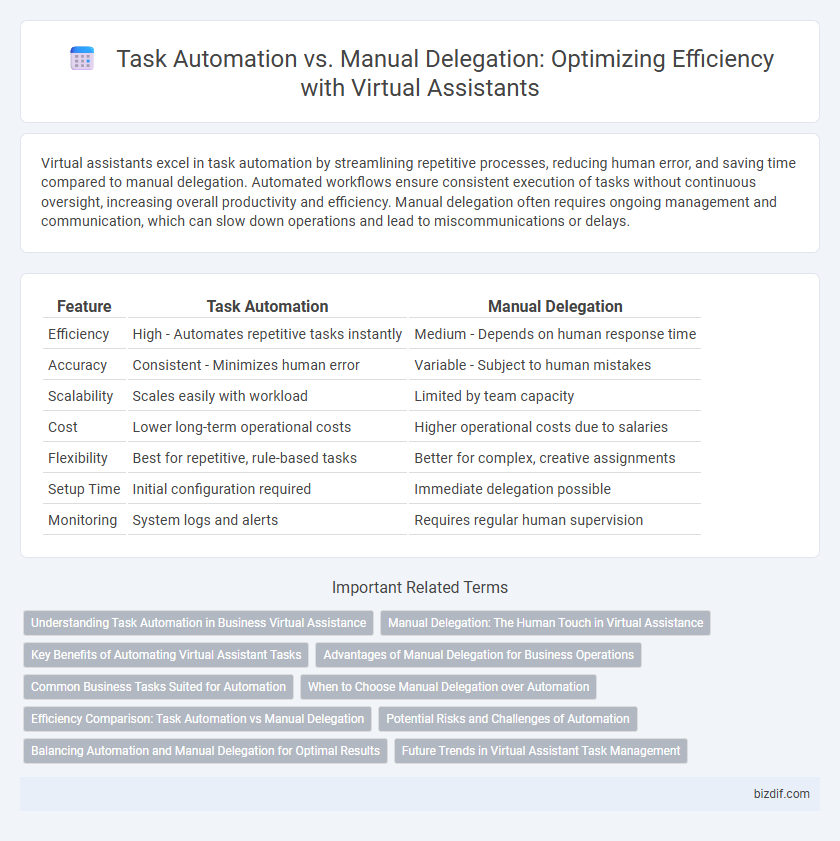Virtual assistants excel in task automation by streamlining repetitive processes, reducing human error, and saving time compared to manual delegation. Automated workflows ensure consistent execution of tasks without continuous oversight, increasing overall productivity and efficiency. Manual delegation often requires ongoing management and communication, which can slow down operations and lead to miscommunications or delays.
Table of Comparison
| Feature | Task Automation | Manual Delegation |
|---|---|---|
| Efficiency | High - Automates repetitive tasks instantly | Medium - Depends on human response time |
| Accuracy | Consistent - Minimizes human error | Variable - Subject to human mistakes |
| Scalability | Scales easily with workload | Limited by team capacity |
| Cost | Lower long-term operational costs | Higher operational costs due to salaries |
| Flexibility | Best for repetitive, rule-based tasks | Better for complex, creative assignments |
| Setup Time | Initial configuration required | Immediate delegation possible |
| Monitoring | System logs and alerts | Requires regular human supervision |
Understanding Task Automation in Business Virtual Assistance
Task automation in business virtual assistance streamlines repetitive processes by utilizing software tools to execute tasks without human intervention, increasing efficiency and reducing errors. Unlike manual delegation, where tasks are assigned to human assistants, automation handles routine activities such as scheduling, email management, and data entry at scale. Implementing task automation enables businesses to optimize resource allocation, improve productivity, and maintain consistent task execution across operations.
Manual Delegation: The Human Touch in Virtual Assistance
Manual delegation in virtual assistance ensures personalized task management by leveraging human judgment and adaptability, which AI-driven automation cannot fully replicate. It enhances communication clarity and reduces errors through direct interaction, fostering stronger client-assistant relationships. This human touch remains crucial for complex tasks requiring nuanced understanding and emotional intelligence.
Key Benefits of Automating Virtual Assistant Tasks
Automating virtual assistant tasks significantly reduces human error and increases efficiency by streamlining repetitive processes such as scheduling, data entry, and email management. This leads to cost savings and faster response times, enhancing overall productivity for businesses. Automated task handling also enables virtual assistants to focus on higher-level responsibilities, improving service quality and customer satisfaction.
Advantages of Manual Delegation for Business Operations
Manual delegation offers businesses enhanced control and personalized oversight in task management, ensuring that complex or sensitive assignments are handled with precision. It fosters clearer communication and accountability among team members, reducing errors and improving workflow efficiency. This approach also allows leaders to leverage individual strengths and adapt quickly to dynamic operational needs.
Common Business Tasks Suited for Automation
Task automation streamlines processes such as scheduling meetings, managing email responses, and generating reports, significantly reducing human error and saving time. Manual delegation remains necessary for complex decisions requiring human judgment, but repetitive tasks like data entry, invoicing, and customer follow-ups are highly suitable for automation tools. Leveraging virtual assistants for these common business tasks enhances operational efficiency and allows employees to focus on strategic initiatives.
When to Choose Manual Delegation over Automation
Manual delegation is preferred when tasks require nuanced judgment, complex decision-making, or personalized communication that automation cannot replicate effectively. Situations involving confidential information or sensitive client interactions benefit from human oversight to ensure accuracy and empathy. Tasks with unpredictable variables or those needing adaptive problem-solving also warrant manual delegation for optimal results.
Efficiency Comparison: Task Automation vs Manual Delegation
Task automation significantly enhances efficiency by executing repetitive tasks with speed and accuracy, reducing human error and freeing up valuable time for strategic activities. Manual delegation requires continuous oversight, often leading to communication delays and inconsistent task execution that hamper productivity. Leveraging automation tools boosts operational workflows and delivers consistent results, making it a superior choice over manual task delegation in dynamic work environments.
Potential Risks and Challenges of Automation
Task automation through virtual assistants reduces manual errors and speeds up workflows but introduces potential risks such as system failures and data breaches. Overreliance on automation can lead to diminished human oversight, increasing vulnerability to incorrect task execution and security threats. Ensuring robust fail-safes, continuous monitoring, and clear escalation protocols is essential to mitigate these challenges.
Balancing Automation and Manual Delegation for Optimal Results
Balancing task automation and manual delegation enhances virtual assistant efficiency by combining precision with human judgment. Automating repetitive tasks boosts productivity and reduces errors, while manual delegation ensures complex, nuanced activities receive personalized attention. Leveraging this hybrid approach maximizes resource utilization and ensures optimal results in virtual assistant workflows.
Future Trends in Virtual Assistant Task Management
Future trends in virtual assistant task management emphasize increased task automation driven by advanced AI and machine learning algorithms, enabling seamless execution of complex workflows without human intervention. Manual delegation is gradually decreasing as virtual assistants gain capabilities to autonomously prioritize, schedule, and complete tasks based on real-time data and user behavior analysis. Integration with Internet of Things (IoT) devices and cloud computing further enhances predictive task management, reducing human effort and optimizing productivity across various industries.
Task automation vs Manual delegation Infographic

 bizdif.com
bizdif.com